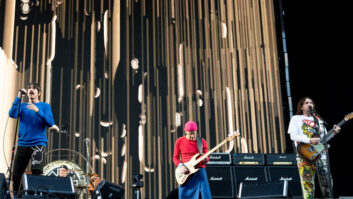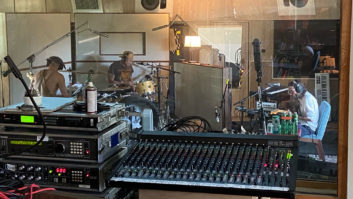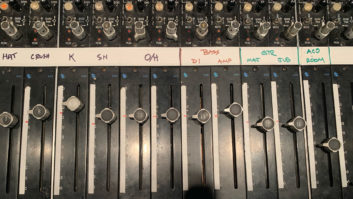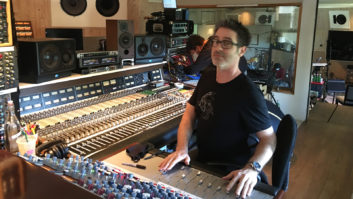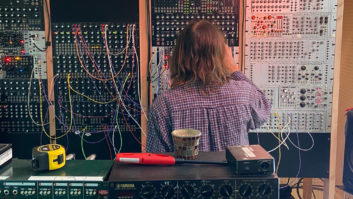RAISE YOUR HAND IF YOU’RE SHURE: Flea, bassist of the Red Hot Chili Peppers, sporting Shure PSM 1000 IEMs.
New York (May 25, 2012)—When LED screens on the current Red Hot Chili Peppers tour began causing serious RF issues for the band’s personal monitor systems, the audio engineering team switched the band to the Shure PSM 1000 system and its diversity reception design.

Over his 20 years of mixing the Red Hot Chili Peppers, Dave Rat of Rat Sound has had to deal with a wide range of audio issues, and that happened again recently on the current multi-year tour in support of the album I’m With You.
“The troubles we were having with our existing in-ear systems were primarily due to the LED stage we have on this tour,” explains Rat. “We experienced a whole new level of interference issues. When you have the artists actually standing on an LED surface, it means the beltpack is only three feet away from the RF noise, while the transmitting antenna is maybe 30 feet away. The result was a lot of dropouts from a system that had previously been very stable. We couldn’t even do frequency scans from the stage.”
Working with the experts at Professional Wireless Systems, Rat tried a number of techniques to address the issue, including increased RF output, an improved antenna system, and a new frequency scheme. “We could get it better, but nothing we tried was good enough,” Rat recalls. “So we decided to give the Shure PSM 1000 a try. Immediately, we saw a huge improvement. Immediately, dropouts were virtually eliminated, and the improved filtering on the diversity receivers lets us scan from the stage again.”
The change was not lost on the band. “Obviously, wireless performance was the main benefit,” says Rat. “But in addition, the sound quality was distinctly better, which is obviously the main job of an in-ear system. In fact, when Anthony [Kiedis] tried the system, he came up and commented on how great it sounded – and he very rarely says anything about audio. I got that from a couple other guys in the band as well.”
Monitor engineer Tim Engwall sets up and operates the IEMs each day. “Now that we have the PSM 1000, I can do a frequency scan from the stage again,” he reports. “Every day, I go onstage, put a bodypack in full scan mode and set up all the frequencies fresh. The system gives me the best group and the cleanest channels, then I sync the channels and walk the room. I listen with pink noise going through the packs, and with nothing going through them, just to make sure everything sounds good all over the stage. Everything’s been working great since we made the change.”
Currently, Red Hot Chili Peppers are touring with eight channels of PSM 1000. Of the six artists onstage, five are on PSM 1000 systems. “The guitarist, Josh Klinghoffer, is on wedges and sidefills, so his channel is actually used by his guitar tech,” says Engwall. “Then we have one system for me, and one spare we can use for a guest artist.”
One final feature that really sold Dave Rat on the PSM 1000 was the ability to set up the bodypack receivers in an artist-friendly way. “The band members really want to see that volume pot on their bodypack at two o’clock. That’s what they’re used to, and that’s what feels right to them,” he says. “Obviously, if you change systems, that value may change. But Shure actually gives you the ability to change the sensitivity of the volume pot on the bodypack, so nothing changes from the artist’s perspective. That was huge for us. It’s kind of like me setting up my console so I can keep all my faders around 0 dB. It puts you in your comfort zone during the show.”
Shure
www.shure.com
Rat Sound
www.ratsound.com
